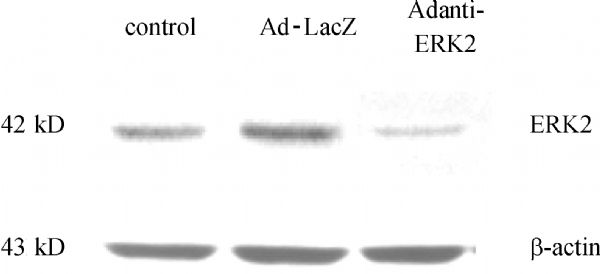

Adenovirus-mediated antisense ERK2 gene therapy ameliorates chronic allograft nephropathy in a rat model
Received date: 05 Jan 2009
Accepted date: 01 Mar 2009
Published date: 05 Jun 2009
Copyright
To investigate the effect and underlying mechanism of adenovirus-mediated antisense ERK2 (Adanti-ERK2) gene therapy upon chronic allograft nephropathy (CAN) of rats, male Lewis (LEW, RT11) rats received male Fisher (F344, RT11v1) renal allografts. The recipients were divided into three groups: (1) empty control group; (2) vector control group; (3) gene therapy group. All recipients were sacrificed for the grafts and serum analysis at the 24th week after transplantation. Morphometric analysis was used to determine the fibrosis of grafts. Immunohistochemistry was used to detect the expression of E-Cadherin, Vimentin, TβR I and the infiltration of CD4+ T lymphocyte, CD8+ T lymphocyte and ED-1+ monocytes. Enzyme linked immunosorbent assay (ELISA) was used to detect TGF-β1 in serum. The grafts in the control group and vector control group showed CAN. There was less E-Cadherin in renal tubular epithelial cells in the empty control group but more Vimentin and TβR I. In the gene therapy group, the fibrosis was ameliorated and fewer T lymphocytes and ED-1+ monocytes infiltrated in the interstitium. There was no significant difference in the expression of E-Cadherin between the gene therapy group and normal rats. Compared with the empty control group, the expression of TGF-β1 in the gene therapy group was down-regulated. Adanti-ERK2 gene therapy protects the renal allograft and attenuates graft fibrosis, which may be correlated with a decreased renal tubular epithelial mesenchymal transition, a decreased infiltration of CD4+ T lymphocyte, CD8+ T lymphocytes and ED-1+ monocytes in renal interstitium, and the down-regulated TGF-β1 expression.

Zhao DING , Zhishui CHEN , Xilin CHEN , Ming CAI , Hui GUO , Nianqiao GONG . Adenovirus-mediated antisense ERK2 gene therapy ameliorates chronic allograft nephropathy in a rat model[J]. Frontiers of Medicine, 2009 , 3(2) : 204 -210 . DOI: 10.1007/s11684-009-0039-0
| 1 |
PascualM, TheruvathT, KawaiT, Tolkoff-RubinN, CosimiA B. Strategies to improve long-term outcomes after renal transplantation. N Engl J Med, 2002, 346(8): 580–590
|
| 2 |
BurnsW C, KantharidisP, ThomasM C. The role of tubular epithelial-mesenchymal transition in progressive kidney disease. Cells Tissues Organs, 2007, 185(1-3): 222–31
|
| 3 |
NankivellB J, BorrowsR J, FungC L, O'ConnellP J, AllenR D, Chapman J R. The natural history of chronic allograft nephropathy. N Engl J Med, 2003, 349(24): 2326–2333
|
| 4 |
KyriakisJ M, AvruchJ. Mammalian mitogen-activated protein kinase signal transduction pathways activated by stress and inflammation. Physiol Rev, 2001, 81(2): 807–869
|
| 5 |
BostF, AouadiM, CaronL, EvenP, BelmonteN, ProtM, DaniC, HofmanP, PagèsG, PouysségurJ, Le Marchand-BrustelY, BinétruyB. The extracellular signal–regulated kinase isoform ERK1 is specifically required for in vitro and in vivo adipogenesis. Diabetes, 2005, 54(2): 402–411
|
| 6 |
VantaggiatoC, FormentiniI, BondanzaA, BoniniC, NaldiniL, BrambillaR. ERK1 and ERK2 mitogen-activated protein kinases affect Ras-dependent cell signaling differentially. J Biol, 2006, 5(5): 14
|
| 7 |
MizuguchiH, KayM A. A simple method for constructing E1- and E1/E4-deleted recombinant adenoviral vectors. Hum Gene Ther, 1999, 10(12): 2013–2017
|
| 8 |
LeeS. An improved technique of renal transplantation in the rat. Surgery, 1967, 61(5): 771–773
|
| 9 |
PascualM, TheruvathT, KawaiT, Tolkoff-RubinN, CosimiA B. Strategies to improve long-term outcomes after renal transplantation. N Engl J Med, 2002, 346(8): 580–590
|
| 10 |
IwanoM, PliethD, DanoffT M, XueC, OkadaH, NeilsonE G. Evidence that fibroblasts derive from epithelium during tissue fibrosis. J Clin Invest, 2002, 110(3): 341–350
|
| 11 |
GongN, ZhangW, LiG, GuoH, YeQ. MAPK cascade pathway and anti-stress response of hepatocyte after live transplantation. Chin J Organ Transplant, 2002, 23(5): 288–290 (in Chinese)
|
| 12 |
LiG, GongN, YeQ, GuoH. Different effects of several signal pathways after liver transplantation. Zhonghua Ganzangbing Zazhi, 2003, 11(12): 742–745 (in Chinese).
|
| 13 |
DongC, GongN, ChenZ, ChenX, XuQ, GuoH, ZengZ, MingC, ChenZ K. Antisense ERK1/2 oligodeoxynucleotide gene therapy attenuates graft arteriosclerosis of aortic transplant in a rat model. Transplant Proc, 2006, 38(10): 3304–3306
|
| 14 |
WhitehurstA W, RobinsonF L, MooreM S, CobbM H. The death effector domain protein PEA-15 prevents nuclear entry of ERK2 by inhibiting required interactions. J Biol Chem, 2004, 279(13): 12840–12847
|
| 15 |
ChenR H, AbateC, BlenisJ. Phosphorylation of the c-Fos transrepression domain by mitogen-activated protein kinase and 90-kDa ribosomal S6 kinase. Proc Natl Acad Sci USA, 1993, 90(23): 10952–10956
|
| 16 |
GongN, PleyerU, VogtK, AnegonI, FlügelA, VolkH D, RitterT. Local overexpression of nerve growth factor in rat corneal transplants improves allograft survival. Invest Ophthalmol Vis Sci, 2007, 48(3): 1043–1052
|
| 17 |
TilneyN L, WhitleyW D, TulliusS G, HeemannU W, WasowskaB, BaldwinW M 3rd, HancockW W. Serial analysis of cytokines, adhesion molecule expression, and humoral responses during development of chronic kidney allograft rejection in a new rat model. Transplant Proc, 1993, 25(1 Pt 2): 861–862
|
| 18 |
TulliusS G, HancockW W, HeemannU, AzumaH, TilneyN L. Reversibility of chronic renal allograft rejection. Critical effect of time after transplantation suggests both host immune dependent and independent phases of progressive injury. Transplantation, 1994, 58(1): 93–99
|
| 19 |
Meindl-BeinkerN M, DooleyS. Transforming growth factor-beta and hepatocyte transdifferentiation in liver fibrogenesis. J Gastroenterol Hepatol, 2008, 23(Suppl 1): S122–S127
|
| 20 |
RobertsonH, AliS, McDonnellB J, BurtA D, KirbyJ A. Chronic renal allograft dysfunction: The role of T cell-mediated tubular epithelial to mesenchymal cell transition. J Am Soc Nephrol, 2004, 15(2): 390–397
|
| 21 |
ReedR C, BerwinB, BakerJ P, NicchittaC V. GRP94/gp96 elicits ERK activation in murine macrophages. A role for endotoxin contamination in NF-kappa B activation and nitric oxide production. J Biol Chem, 2003, 278(34): 31853–31860
|
| 22 |
ZhangY L, DongC. MAP kinases in immune responses. Cell Mol Immunol, 2005, 2(1): 20–27
|
/
| 〈 |
|
〉 |